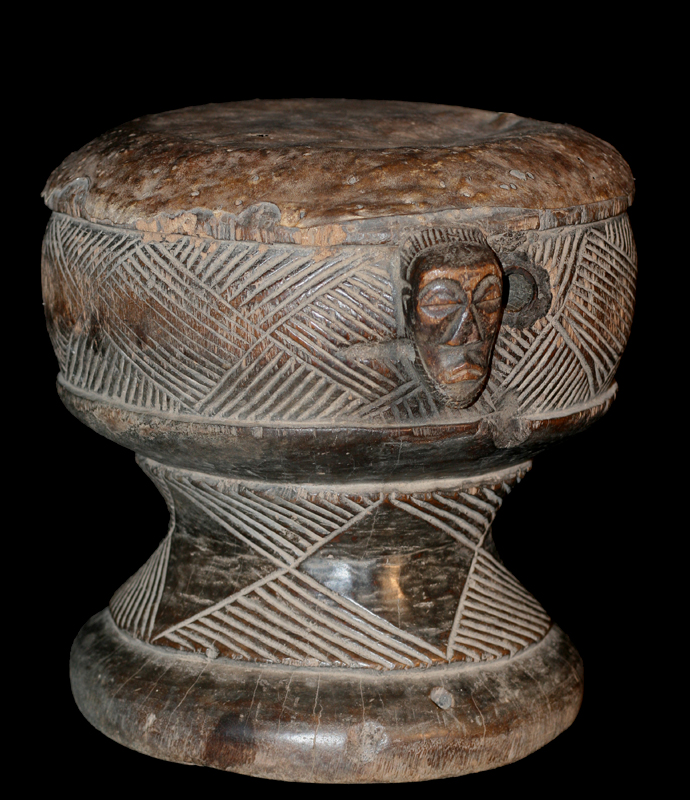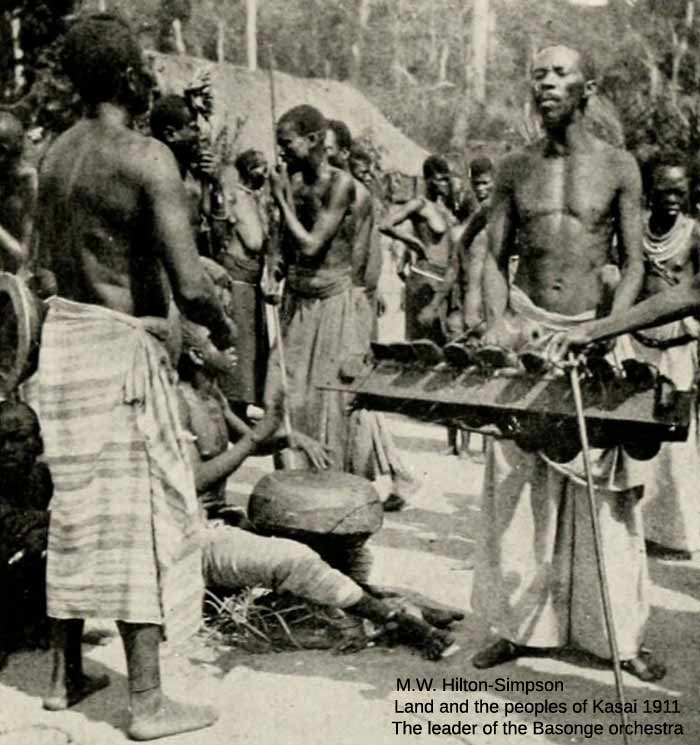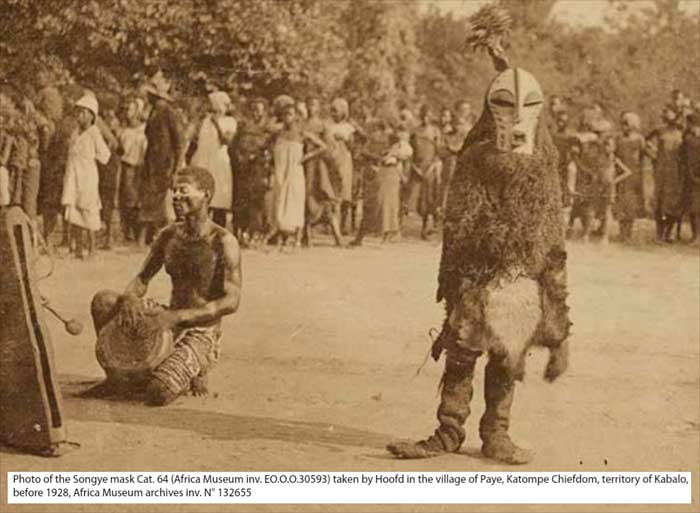DRUMS OF THE WORLD
Africa
songye drum congo
Songye / Basongye drum / Trommel / Tambour Congo
"Society needs the services of musicians, for without music, normal life patterns simply cannot continue, at least as that society is currently construed by its members. Without the ngomba, the traveling professional, a major funeral cannot take place; without the ntunda, celebration of the village protector figure cannot operate on its regular lunar cycle. Birth, death, and most major events in between take place to the accompaniment of, or are celebrated through, music of one form or another."
"Though as an individual [the musician] may be scorned and stereotyped as a person of little consequence, his functions in the society make him essential. Indeed, nonmusicians, when proffered the suggestion that the village might be better off if these n'er-do-wells were banished from it, reacted with seriousness and, in some cases, almost horror. Life in a village without musicians is not to be considered, and people spoke of leaving the village were no musicians present. This reaction cannot be taken lightly, for the bonds of kinship and economics which tie an individual to his village are extremely difficult to break. Without musicians a village is incomplete. People want to be happy, and music-making is associated closely with happiness. (...) Musicians perform a variety of functions in village life which no one else can replace; life without them cannot be normal and is not to be contemplated seriously."
Alan P. Merriam : Basongye Musicians and Institutionalized Social Deviance.
Source: Yearbook of the International Folk Music Council, Vol. 11 (1979), pp. 1-26
"Kifwebe masks were made for the Bwadi ya Kifwebe association, a type of policing society that provided a means of controlling social behavior and neutralizing disruptive elements within the group. These masks appeared at the installation and death of a chief, and at the initiation rites of young men as well as a whole range of occasions that included punishments, warfare and public works. There is great variety and symbolism within the various Kifwebe masks. More than thirty different mask names have been recorded. Several have animal names while other masks have names of illnesses like leprosy or names denoting natural phenomena. For the most part Kifwebe masks no longer function to maintain social control among the Songye except in the southeastern regions bordering on Luba territory." Excerpt from - Beauty and the Beasts: Kifwebe and Animal Masks of the Songye, Luba and Related Peoples by Marc Leo Felix
Bibliography:
Alan P. Merriam : Basongye Musicians and Institutionalized Social Deviance. Source : Yearbook of the International Folk Music Council, Vol. 11 (1979)
M.W. Hilton-Simpson : "Land and peoples of the Kasai; being a narrative of a two years' journey among the cannibals of the equatorial forest and other savage tribes of the south-western Congo" (1911)
Francois Neyt : Songye - The Formidable Statuary of Central Africa.
Felix Marc Leo : Beauty and the Beasts - Kifwebe and Animal Masks of the Songye, Luba and Related Peoples.Tribal Arts S.P.R.I 2003
Dunja Hersak : Songye - Masks and Figure Sculpture
Jean Willy Mestach : Etudes Songye - Songye Studies Form and Symbolism an Analytical Essay 1985
Julien Volper : Under the influence of the Songye 2012
François Neyt : Kifwebe : A Century of Songye and Luba Masks 2019
"Society needs the services of musicians, for without music, normal life patterns simply cannot continue, at least as that society is currently construed by its members. Without the ngomba, the traveling professional, a major funeral cannot take place; without the ntunda, celebration of the village protector figure cannot operate on its regular lunar cycle. Birth, death, and most major events in between take place to the accompaniment of, or are celebrated through, music of one form or another."
"Though as an individual [the musician] may be scorned and stereotyped as a person of little consequence, his functions in the society make him essential. Indeed, nonmusicians, when proffered the suggestion that the village might be better off if these n'er-do-wells were banished from it, reacted with seriousness and, in some cases, almost horror. Life in a village without musicians is not to be considered, and people spoke of leaving the village were no musicians present. This reaction cannot be taken lightly, for the bonds of kinship and economics which tie an individual to his village are extremely difficult to break. Without musicians a village is incomplete. People want to be happy, and music-making is associated closely with happiness. (...) Musicians perform a variety of functions in village life which no one else can replace; life without them cannot be normal and is not to be contemplated seriously."
Alan P. Merriam : Basongye Musicians and Institutionalized Social Deviance.
Source: Yearbook of the International Folk Music Council, Vol. 11 (1979), pp. 1-26
"Kifwebe masks were made for the Bwadi ya Kifwebe association, a type of policing society that provided a means of controlling social behavior and neutralizing disruptive elements within the group. These masks appeared at the installation and death of a chief, and at the initiation rites of young men as well as a whole range of occasions that included punishments, warfare and public works. There is great variety and symbolism within the various Kifwebe masks. More than thirty different mask names have been recorded. Several have animal names while other masks have names of illnesses like leprosy or names denoting natural phenomena. For the most part Kifwebe masks no longer function to maintain social control among the Songye except in the southeastern regions bordering on Luba territory." Excerpt from - Beauty and the Beasts: Kifwebe and Animal Masks of the Songye, Luba and Related Peoples by Marc Leo Felix
Bibliography:
Alan P. Merriam : Basongye Musicians and Institutionalized Social Deviance. Source : Yearbook of the International Folk Music Council, Vol. 11 (1979)
M.W. Hilton-Simpson : "Land and peoples of the Kasai; being a narrative of a two years' journey among the cannibals of the equatorial forest and other savage tribes of the south-western Congo" (1911)
Francois Neyt : Songye - The Formidable Statuary of Central Africa.
Felix Marc Leo : Beauty and the Beasts - Kifwebe and Animal Masks of the Songye, Luba and Related Peoples.Tribal Arts S.P.R.I 2003
Dunja Hersak : Songye - Masks and Figure Sculpture
Jean Willy Mestach : Etudes Songye - Songye Studies Form and Symbolism an Analytical Essay 1985
Julien Volper : Under the influence of the Songye 2012
François Neyt : Kifwebe : A Century of Songye and Luba Masks 2019



